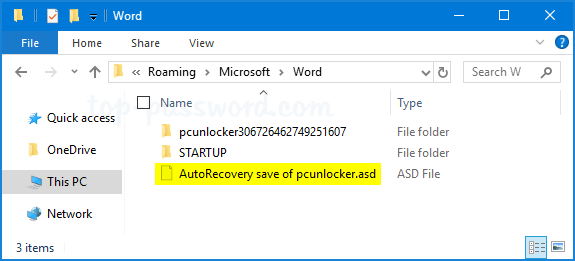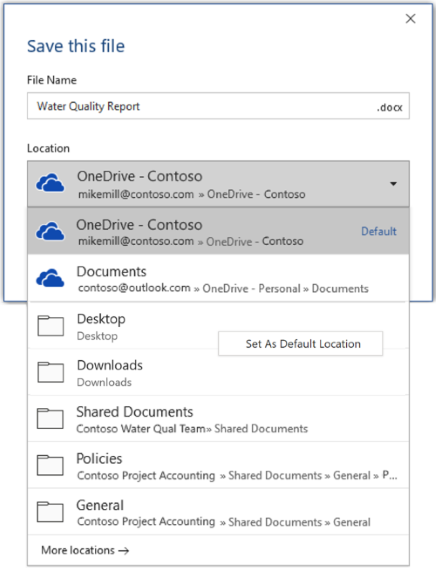
One way to find it is in the Immediate Window of the vba Editor type the following and press Enter.ĭebug.print (wdStartupPath)
Where are word temp files stored 2007 how to#
See Startup Folder for an explanation of what this folder is and how to find its location. Startup Folder and Workgroup Templates Folder For more on this, see my page File New Variations in the Versions of Word. Its location is set under File>Options>Save. It is the default save location for all custom templates for all Office applications. Office 2013 introduced the Custom Office Templates folder which can be different from the User Templates folder. (QAT modifications can be stored in other templates through the user interface.)Ĭode: debug.print (wdUserTemplatesPath)Ĭustom Office Templates Folder (Office 2013 and later) Those modifications are stored in the file Word.officeUI along with QAT modifications. In versions 2010 and later, it is possible to make modifications through the user interface. See Customize the Ribbon (It doesn't take rocket science) by Greg Maxey. However, the best modifications are actually stored in XML modifications to custom templates. There is no built-in Ribbon modification in Word 2007. Doing this gives more options for icons than those available through the interface. See RibbonX: Customizing the Office 2007 Ribbon - by Robert Martin, Ken Puls, and Theresa Hennig and Modify Quick Access Toolbar (QAT) Button Image or Text by Greg Maxey. Generally these will need to be macro-enabled.

If changes are made to the QAT using XML rather than using the Word Interface, they also can be stored in any xml document or template. See also How to reset user options and registry settings in Word - Microsoft Support paper See What exactly does the Data Key in the Registry Store? I don't pretend to know what they are about. I advise storing somewhere other than the default file. Those stored in a document are available only in the document. Otherwise, QAT changes stored in a template are available in any document attached to the template. If the template is a global template, the QAT changes will be available in all Word documents and templates. QAT changes through the interface can also be stored in any document or template. See Locations where QAT modifications are stored on my site for the latest information on this. If both Word 2010-2019 are on the same computer, they will share this file and Word 2013 may reorder the entries. In Word 2010-2019 changes to the QAT made through the Word Interface are stored by default in the file Word.officeUI not in the. (AutoComplete does not work in Word 2007 in Word 2013 and later AutoComplete will work with AutoText stored in any template that is attached or loaded.) AutoText has been available since Word 97 at least.Ĭode: C:\Users\%Username%\AppData\Roaming\Microsoft\OFFICE\Word.qat (Word 2007)Īlso may be saved in a document template or document but cannot be displayed from a global template loaded other than the Normal template Where can Building Blocks be stored?ĪutoText is a type of Building Block but must be stored in Normal.dotm or in the attached template for AutoComplete (a/k/a tooltips) to work in Word 2010. If they are in a Startup folder they can hold other customizations as global templates and will show up in the Add-Ins list. They can also be made global by storing them in the Word Startup Folder or the Office Startup Folder. They will be available as storage locations for new building blocks.

These templates will not show up in the template Add-Ins list, though.
/Webp.net-resizeimage3-5b75095bc9e77c0050130ee6.jpg)
If the template is stored in the Document Building Blocks folder (above) the building blocks will be available in all Word documents. The folder for Word 2010 is 14 for Word 2013 it is 15 for Word 2016 it is 16.īuilding Blocks can be stored in any template. That file, though, is not used to store any custom building blocks. The filename of the default building blocks file in Word 2010-2016 is "Built-In Building Blocks.dotx" and it may be stored in a version-specific subfolder. Code: C:\Users\%Username%\AppData\Roaming\Microsoft\Document Building Blocks\1033\Building Blocks.dotxC:\Users\%Username%\AppData\Roaming\Microsoft\Temp lates\LiveContent\User\Word Document Building Blocks\1033\Building Blocks.dotxĬan also be stored in a document template or global template


 0 kommentar(er)
0 kommentar(er)
